Business Environment Analysis: NHS and Sainsbury's - Semester 2
VerifiedAdded on 2020/06/04
|9
|2731
|242
Report
AI Summary
This report provides a comparative analysis of the business environments of the National Health Service (NHS) and Sainsbury's. It begins by outlining the types, purposes, and ownership structures of these two contrasting businesses, highlighting the NHS as a publicly funded health service and Sainsbury's as a retail chain. The report then examines the stakeholders influencing each business's purpose, including suppliers, customers, investors, and employees. It delves into the organizational structures of the two businesses, comparing matrix, product, functional, and geographic structures, and explaining how these structures support their respective goals. Furthermore, the report explores the influence of different economic environments, such as free market, transitional, command, and mixed economies, on the activities of both organizations. Finally, it assesses the impact of political, legal, and social factors on the business activities of NHS and Sainsbury's, including political stability, legal regulations, and social impacts related to recruitment and societal changes. The report concludes by summarizing the key findings and implications of the analysis.
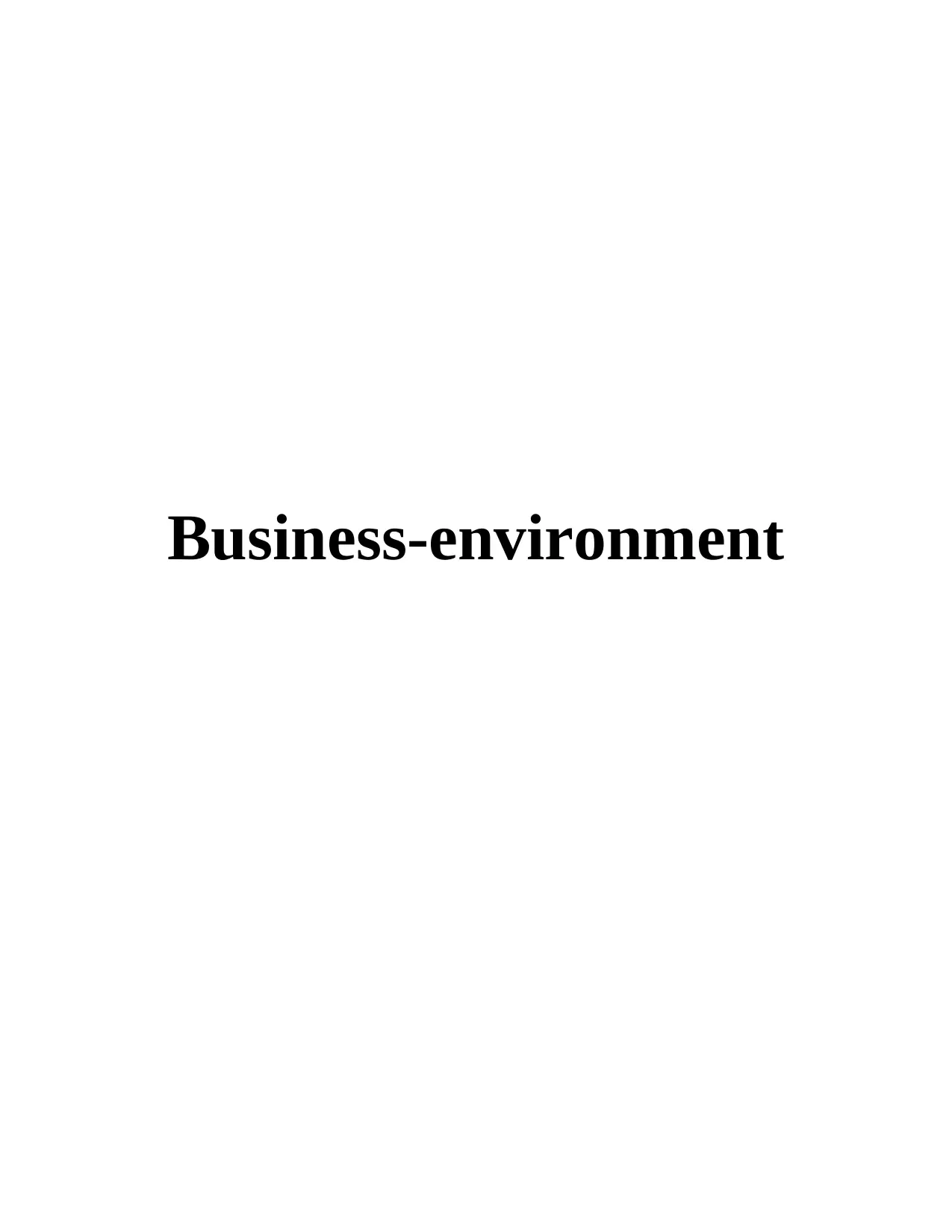
Business-environment
Paraphrase This Document
Need a fresh take? Get an instant paraphrase of this document with our AI Paraphraser
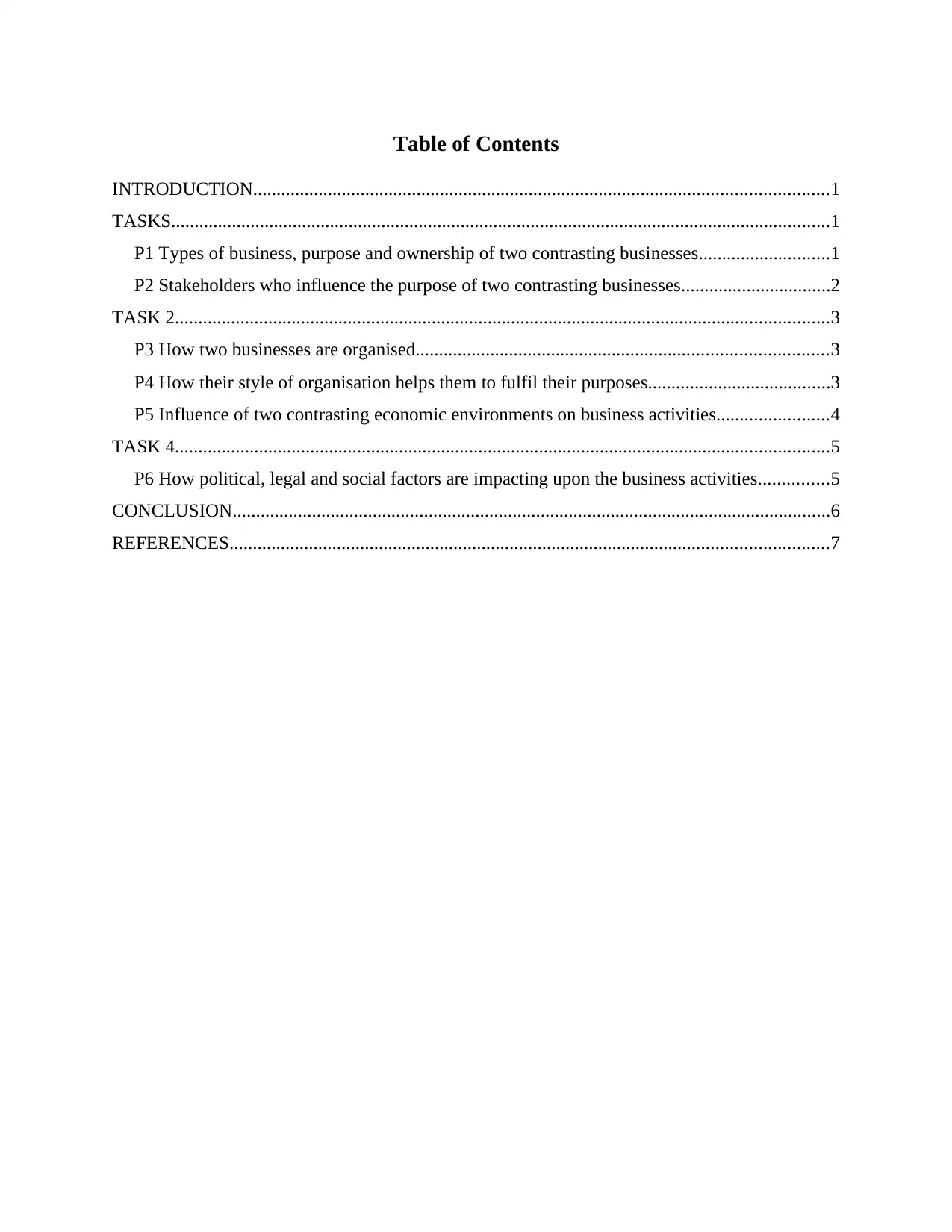
Table of Contents
INTRODUCTION...........................................................................................................................1
TASKS.............................................................................................................................................1
P1 Types of business, purpose and ownership of two contrasting businesses............................1
P2 Stakeholders who influence the purpose of two contrasting businesses................................2
TASK 2............................................................................................................................................3
P3 How two businesses are organised........................................................................................3
P4 How their style of organisation helps them to fulfil their purposes.......................................3
P5 Influence of two contrasting economic environments on business activities........................4
TASK 4............................................................................................................................................5
P6 How political, legal and social factors are impacting upon the business activities...............5
CONCLUSION................................................................................................................................6
REFERENCES................................................................................................................................7
INTRODUCTION...........................................................................................................................1
TASKS.............................................................................................................................................1
P1 Types of business, purpose and ownership of two contrasting businesses............................1
P2 Stakeholders who influence the purpose of two contrasting businesses................................2
TASK 2............................................................................................................................................3
P3 How two businesses are organised........................................................................................3
P4 How their style of organisation helps them to fulfil their purposes.......................................3
P5 Influence of two contrasting economic environments on business activities........................4
TASK 4............................................................................................................................................5
P6 How political, legal and social factors are impacting upon the business activities...............5
CONCLUSION................................................................................................................................6
REFERENCES................................................................................................................................7
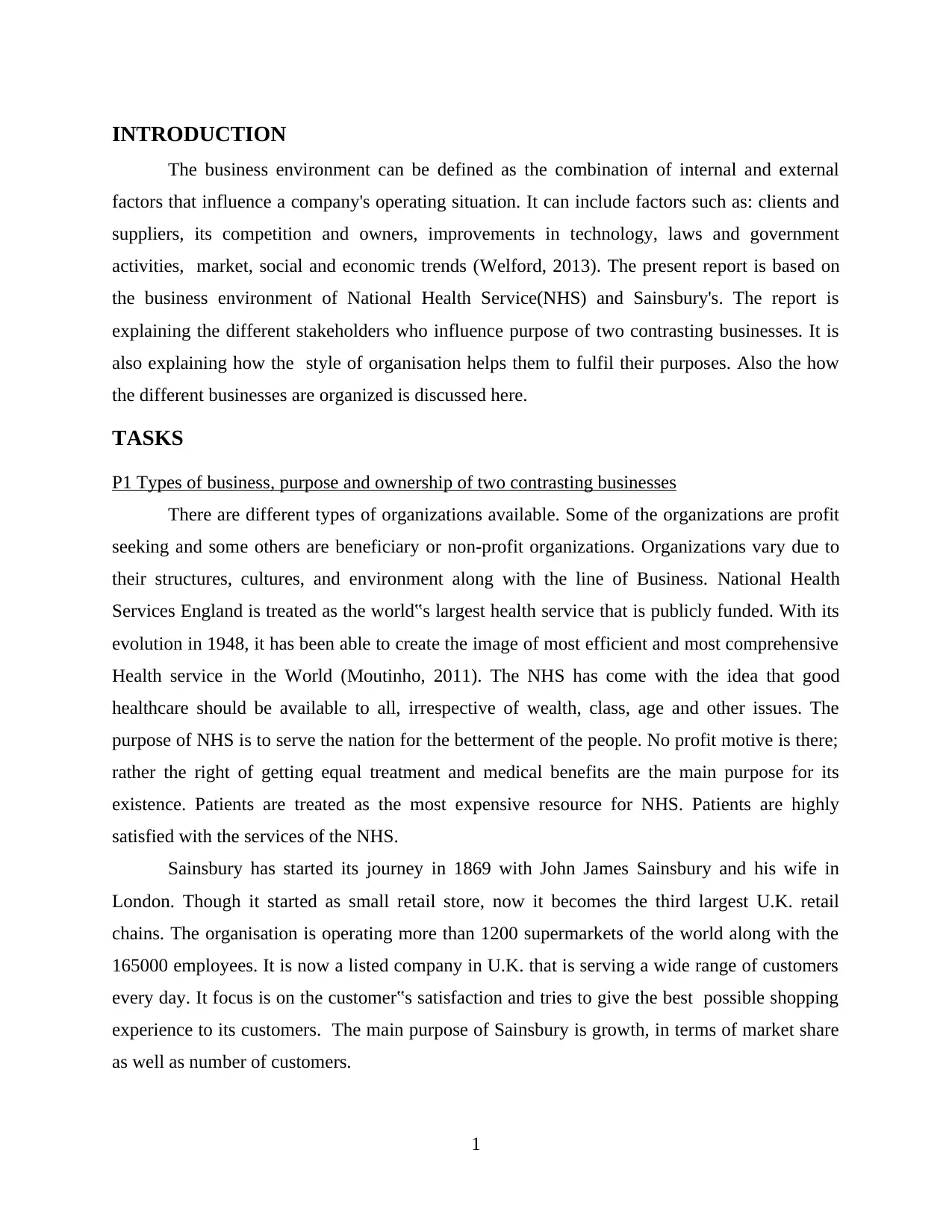
INTRODUCTION
The business environment can be defined as the combination of internal and external
factors that influence a company's operating situation. It can include factors such as: clients and
suppliers, its competition and owners, improvements in technology, laws and government
activities, market, social and economic trends (Welford, 2013). The present report is based on
the business environment of National Health Service(NHS) and Sainsbury's. The report is
explaining the different stakeholders who influence purpose of two contrasting businesses. It is
also explaining how the style of organisation helps them to fulfil their purposes. Also the how
the different businesses are organized is discussed here.
TASKS
P1 Types of business, purpose and ownership of two contrasting businesses
There are different types of organizations available. Some of the organizations are profit
seeking and some others are beneficiary or non-profit organizations. Organizations vary due to
their structures, cultures, and environment along with the line of Business. National Health
Services England is treated as the world‟s largest health service that is publicly funded. With its
evolution in 1948, it has been able to create the image of most efficient and most comprehensive
Health service in the World (Moutinho, 2011). The NHS has come with the idea that good
healthcare should be available to all, irrespective of wealth, class, age and other issues. The
purpose of NHS is to serve the nation for the betterment of the people. No profit motive is there;
rather the right of getting equal treatment and medical benefits are the main purpose for its
existence. Patients are treated as the most expensive resource for NHS. Patients are highly
satisfied with the services of the NHS.
Sainsbury has started its journey in 1869 with John James Sainsbury and his wife in
London. Though it started as small retail store, now it becomes the third largest U.K. retail
chains. The organisation is operating more than 1200 supermarkets of the world along with the
165000 employees. It is now a listed company in U.K. that is serving a wide range of customers
every day. It focus is on the customer‟s satisfaction and tries to give the best possible shopping
experience to its customers. The main purpose of Sainsbury is growth, in terms of market share
as well as number of customers.
1
The business environment can be defined as the combination of internal and external
factors that influence a company's operating situation. It can include factors such as: clients and
suppliers, its competition and owners, improvements in technology, laws and government
activities, market, social and economic trends (Welford, 2013). The present report is based on
the business environment of National Health Service(NHS) and Sainsbury's. The report is
explaining the different stakeholders who influence purpose of two contrasting businesses. It is
also explaining how the style of organisation helps them to fulfil their purposes. Also the how
the different businesses are organized is discussed here.
TASKS
P1 Types of business, purpose and ownership of two contrasting businesses
There are different types of organizations available. Some of the organizations are profit
seeking and some others are beneficiary or non-profit organizations. Organizations vary due to
their structures, cultures, and environment along with the line of Business. National Health
Services England is treated as the world‟s largest health service that is publicly funded. With its
evolution in 1948, it has been able to create the image of most efficient and most comprehensive
Health service in the World (Moutinho, 2011). The NHS has come with the idea that good
healthcare should be available to all, irrespective of wealth, class, age and other issues. The
purpose of NHS is to serve the nation for the betterment of the people. No profit motive is there;
rather the right of getting equal treatment and medical benefits are the main purpose for its
existence. Patients are treated as the most expensive resource for NHS. Patients are highly
satisfied with the services of the NHS.
Sainsbury has started its journey in 1869 with John James Sainsbury and his wife in
London. Though it started as small retail store, now it becomes the third largest U.K. retail
chains. The organisation is operating more than 1200 supermarkets of the world along with the
165000 employees. It is now a listed company in U.K. that is serving a wide range of customers
every day. It focus is on the customer‟s satisfaction and tries to give the best possible shopping
experience to its customers. The main purpose of Sainsbury is growth, in terms of market share
as well as number of customers.
1
⊘ This is a preview!⊘
Do you want full access?
Subscribe today to unlock all pages.

Trusted by 1+ million students worldwide
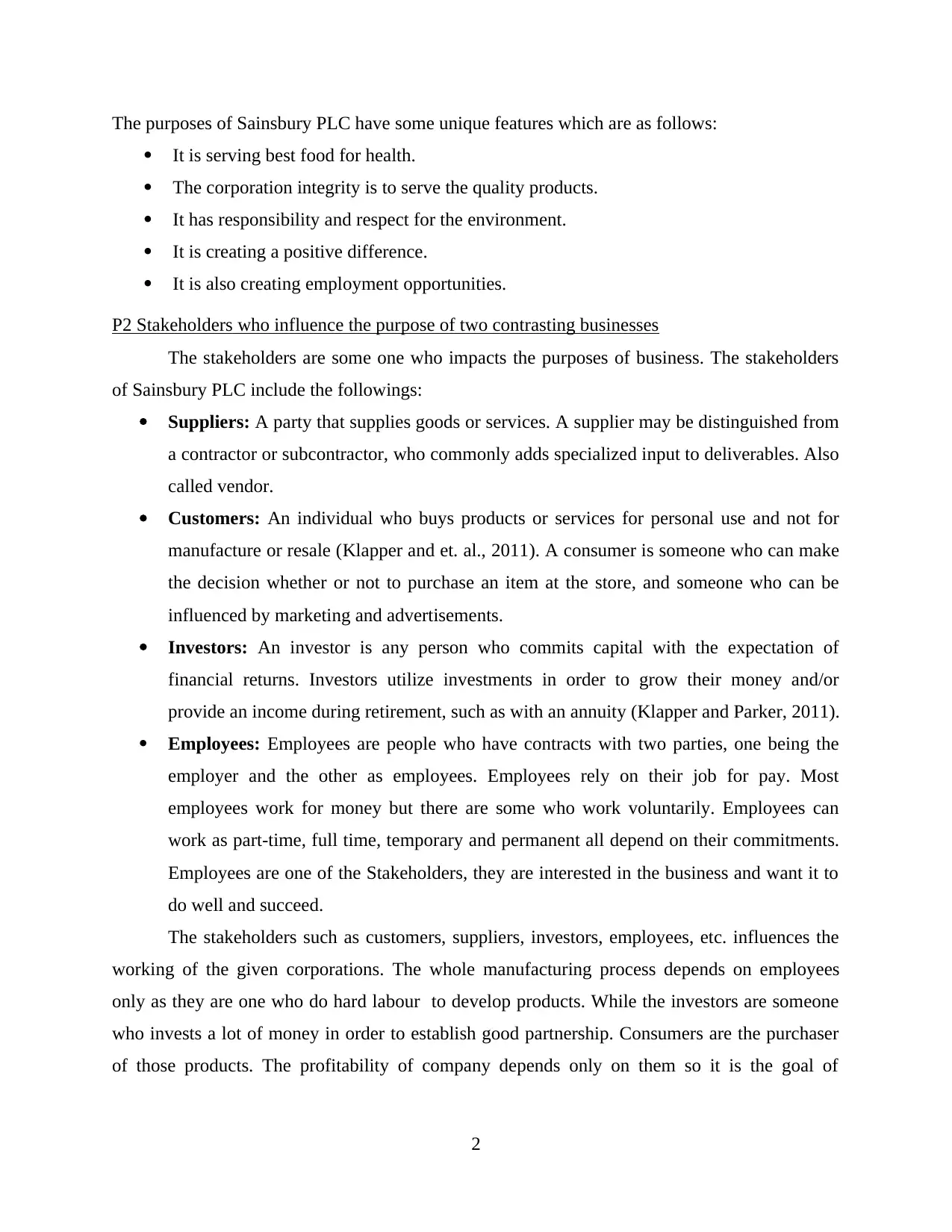
The purposes of Sainsbury PLC have some unique features which are as follows:
It is serving best food for health.
The corporation integrity is to serve the quality products.
It has responsibility and respect for the environment.
It is creating a positive difference.
It is also creating employment opportunities.
P2 Stakeholders who influence the purpose of two contrasting businesses
The stakeholders are some one who impacts the purposes of business. The stakeholders
of Sainsbury PLC include the followings:
Suppliers: A party that supplies goods or services. A supplier may be distinguished from
a contractor or subcontractor, who commonly adds specialized input to deliverables. Also
called vendor.
Customers: An individual who buys products or services for personal use and not for
manufacture or resale (Klapper and et. al., 2011). A consumer is someone who can make
the decision whether or not to purchase an item at the store, and someone who can be
influenced by marketing and advertisements.
Investors: An investor is any person who commits capital with the expectation of
financial returns. Investors utilize investments in order to grow their money and/or
provide an income during retirement, such as with an annuity (Klapper and Parker, 2011).
Employees: Employees are people who have contracts with two parties, one being the
employer and the other as employees. Employees rely on their job for pay. Most
employees work for money but there are some who work voluntarily. Employees can
work as part-time, full time, temporary and permanent all depend on their commitments.
Employees are one of the Stakeholders, they are interested in the business and want it to
do well and succeed.
The stakeholders such as customers, suppliers, investors, employees, etc. influences the
working of the given corporations. The whole manufacturing process depends on employees
only as they are one who do hard labour to develop products. While the investors are someone
who invests a lot of money in order to establish good partnership. Consumers are the purchaser
of those products. The profitability of company depends only on them so it is the goal of
2
It is serving best food for health.
The corporation integrity is to serve the quality products.
It has responsibility and respect for the environment.
It is creating a positive difference.
It is also creating employment opportunities.
P2 Stakeholders who influence the purpose of two contrasting businesses
The stakeholders are some one who impacts the purposes of business. The stakeholders
of Sainsbury PLC include the followings:
Suppliers: A party that supplies goods or services. A supplier may be distinguished from
a contractor or subcontractor, who commonly adds specialized input to deliverables. Also
called vendor.
Customers: An individual who buys products or services for personal use and not for
manufacture or resale (Klapper and et. al., 2011). A consumer is someone who can make
the decision whether or not to purchase an item at the store, and someone who can be
influenced by marketing and advertisements.
Investors: An investor is any person who commits capital with the expectation of
financial returns. Investors utilize investments in order to grow their money and/or
provide an income during retirement, such as with an annuity (Klapper and Parker, 2011).
Employees: Employees are people who have contracts with two parties, one being the
employer and the other as employees. Employees rely on their job for pay. Most
employees work for money but there are some who work voluntarily. Employees can
work as part-time, full time, temporary and permanent all depend on their commitments.
Employees are one of the Stakeholders, they are interested in the business and want it to
do well and succeed.
The stakeholders such as customers, suppliers, investors, employees, etc. influences the
working of the given corporations. The whole manufacturing process depends on employees
only as they are one who do hard labour to develop products. While the investors are someone
who invests a lot of money in order to establish good partnership. Consumers are the purchaser
of those products. The profitability of company depends only on them so it is the goal of
2
Paraphrase This Document
Need a fresh take? Get an instant paraphrase of this document with our AI Paraphraser
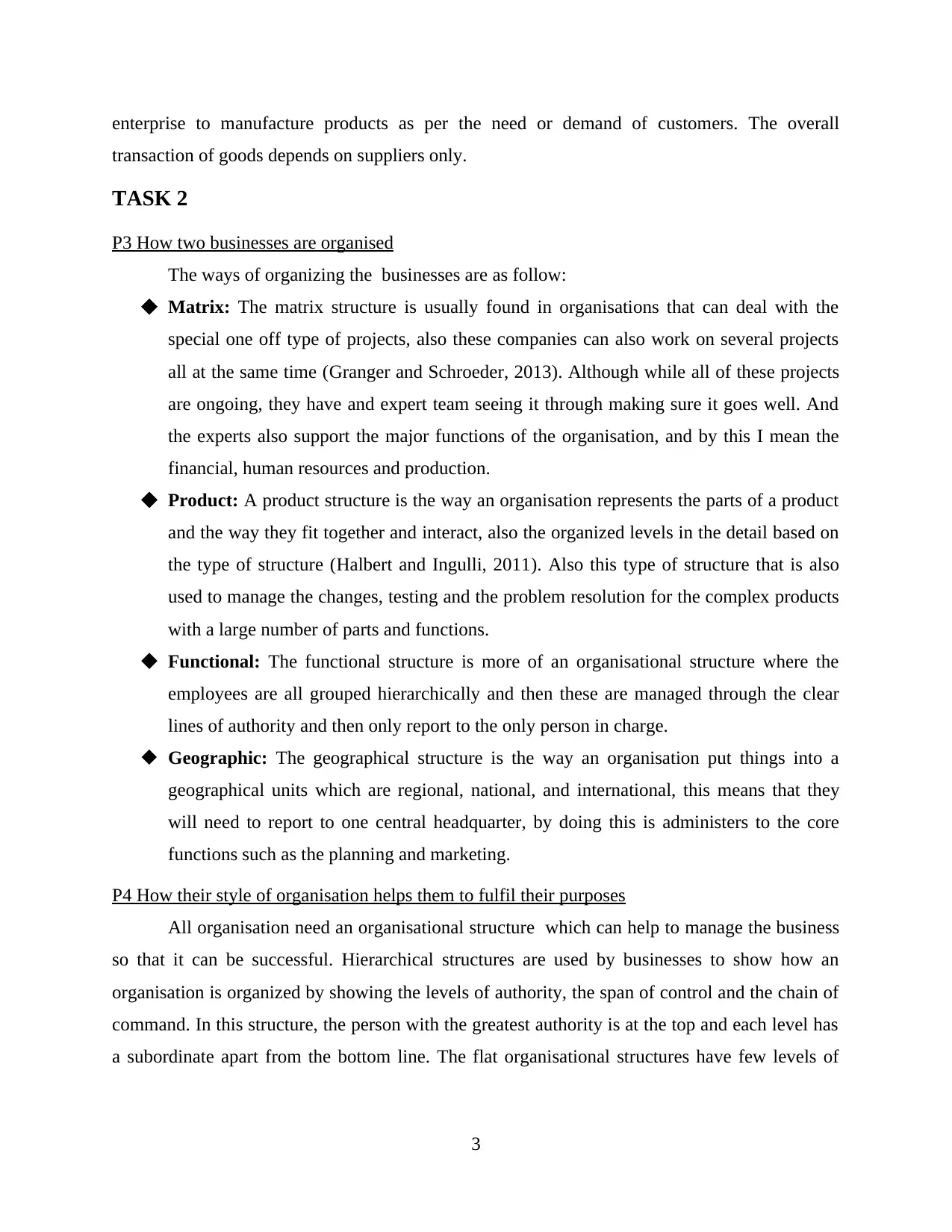
enterprise to manufacture products as per the need or demand of customers. The overall
transaction of goods depends on suppliers only.
TASK 2
P3 How two businesses are organised
The ways of organizing the businesses are as follow:
Matrix: The matrix structure is usually found in organisations that can deal with the
special one off type of projects, also these companies can also work on several projects
all at the same time (Granger and Schroeder, 2013). Although while all of these projects
are ongoing, they have and expert team seeing it through making sure it goes well. And
the experts also support the major functions of the organisation, and by this I mean the
financial, human resources and production.
Product: A product structure is the way an organisation represents the parts of a product
and the way they fit together and interact, also the organized levels in the detail based on
the type of structure (Halbert and Ingulli, 2011). Also this type of structure that is also
used to manage the changes, testing and the problem resolution for the complex products
with a large number of parts and functions.
Functional: The functional structure is more of an organisational structure where the
employees are all grouped hierarchically and then these are managed through the clear
lines of authority and then only report to the only person in charge.
Geographic: The geographical structure is the way an organisation put things into a
geographical units which are regional, national, and international, this means that they
will need to report to one central headquarter, by doing this is administers to the core
functions such as the planning and marketing.
P4 How their style of organisation helps them to fulfil their purposes
All organisation need an organisational structure which can help to manage the business
so that it can be successful. Hierarchical structures are used by businesses to show how an
organisation is organized by showing the levels of authority, the span of control and the chain of
command. In this structure, the person with the greatest authority is at the top and each level has
a subordinate apart from the bottom line. The flat organisational structures have few levels of
3
transaction of goods depends on suppliers only.
TASK 2
P3 How two businesses are organised
The ways of organizing the businesses are as follow:
Matrix: The matrix structure is usually found in organisations that can deal with the
special one off type of projects, also these companies can also work on several projects
all at the same time (Granger and Schroeder, 2013). Although while all of these projects
are ongoing, they have and expert team seeing it through making sure it goes well. And
the experts also support the major functions of the organisation, and by this I mean the
financial, human resources and production.
Product: A product structure is the way an organisation represents the parts of a product
and the way they fit together and interact, also the organized levels in the detail based on
the type of structure (Halbert and Ingulli, 2011). Also this type of structure that is also
used to manage the changes, testing and the problem resolution for the complex products
with a large number of parts and functions.
Functional: The functional structure is more of an organisational structure where the
employees are all grouped hierarchically and then these are managed through the clear
lines of authority and then only report to the only person in charge.
Geographic: The geographical structure is the way an organisation put things into a
geographical units which are regional, national, and international, this means that they
will need to report to one central headquarter, by doing this is administers to the core
functions such as the planning and marketing.
P4 How their style of organisation helps them to fulfil their purposes
All organisation need an organisational structure which can help to manage the business
so that it can be successful. Hierarchical structures are used by businesses to show how an
organisation is organized by showing the levels of authority, the span of control and the chain of
command. In this structure, the person with the greatest authority is at the top and each level has
a subordinate apart from the bottom line. The flat organisational structures have few levels of
3
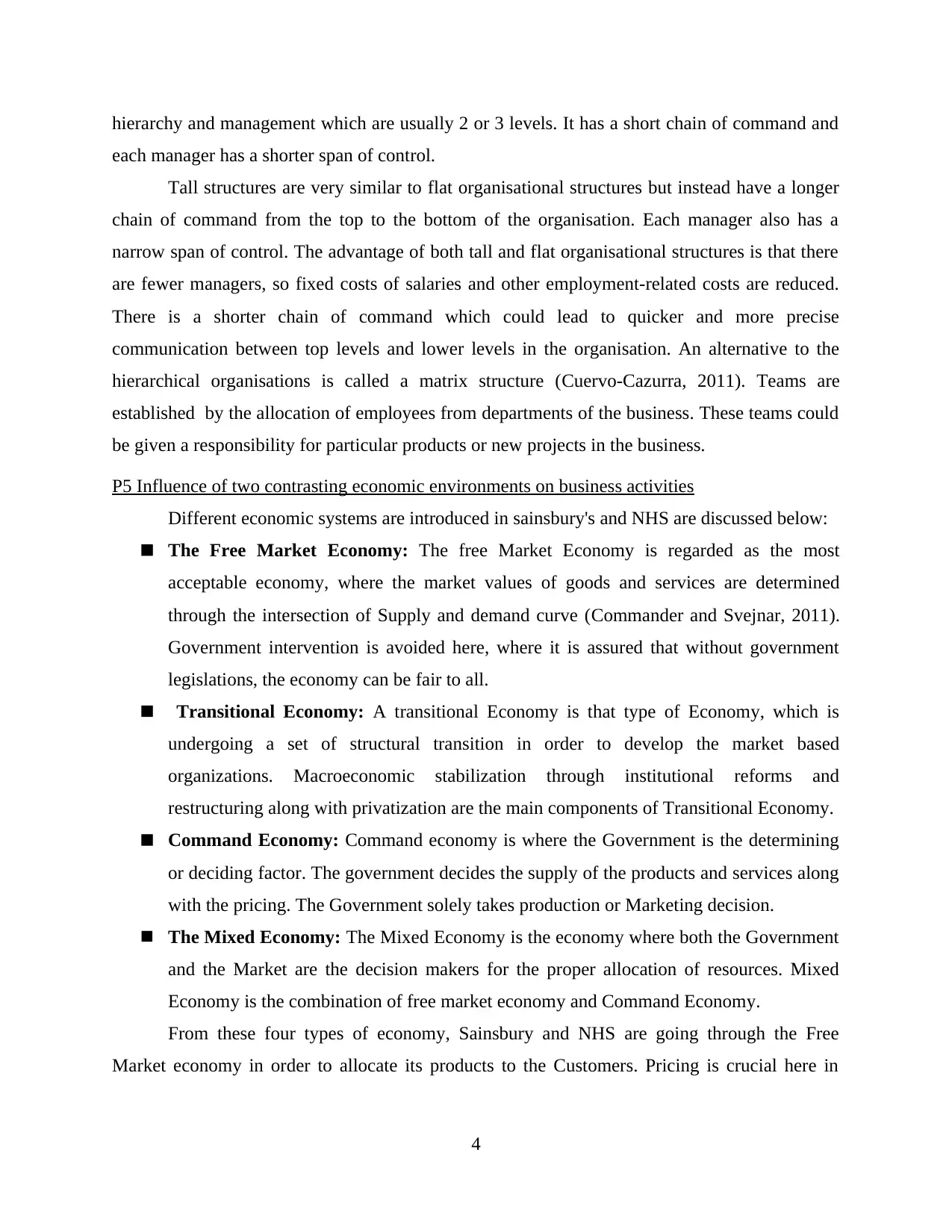
hierarchy and management which are usually 2 or 3 levels. It has a short chain of command and
each manager has a shorter span of control.
Tall structures are very similar to flat organisational structures but instead have a longer
chain of command from the top to the bottom of the organisation. Each manager also has a
narrow span of control. The advantage of both tall and flat organisational structures is that there
are fewer managers, so fixed costs of salaries and other employment-related costs are reduced.
There is a shorter chain of command which could lead to quicker and more precise
communication between top levels and lower levels in the organisation. An alternative to the
hierarchical organisations is called a matrix structure (Cuervo‐Cazurra, 2011). Teams are
established by the allocation of employees from departments of the business. These teams could
be given a responsibility for particular products or new projects in the business.
P5 Influence of two contrasting economic environments on business activities
Different economic systems are introduced in sainsbury's and NHS are discussed below:
The Free Market Economy: The free Market Economy is regarded as the most
acceptable economy, where the market values of goods and services are determined
through the intersection of Supply and demand curve (Commander and Svejnar, 2011).
Government intervention is avoided here, where it is assured that without government
legislations, the economy can be fair to all.
Transitional Economy: A transitional Economy is that type of Economy, which is
undergoing a set of structural transition in order to develop the market based
organizations. Macroeconomic stabilization through institutional reforms and
restructuring along with privatization are the main components of Transitional Economy.
Command Economy: Command economy is where the Government is the determining
or deciding factor. The government decides the supply of the products and services along
with the pricing. The Government solely takes production or Marketing decision.
The Mixed Economy: The Mixed Economy is the economy where both the Government
and the Market are the decision makers for the proper allocation of resources. Mixed
Economy is the combination of free market economy and Command Economy.
From these four types of economy, Sainsbury and NHS are going through the Free
Market economy in order to allocate its products to the Customers. Pricing is crucial here in
4
each manager has a shorter span of control.
Tall structures are very similar to flat organisational structures but instead have a longer
chain of command from the top to the bottom of the organisation. Each manager also has a
narrow span of control. The advantage of both tall and flat organisational structures is that there
are fewer managers, so fixed costs of salaries and other employment-related costs are reduced.
There is a shorter chain of command which could lead to quicker and more precise
communication between top levels and lower levels in the organisation. An alternative to the
hierarchical organisations is called a matrix structure (Cuervo‐Cazurra, 2011). Teams are
established by the allocation of employees from departments of the business. These teams could
be given a responsibility for particular products or new projects in the business.
P5 Influence of two contrasting economic environments on business activities
Different economic systems are introduced in sainsbury's and NHS are discussed below:
The Free Market Economy: The free Market Economy is regarded as the most
acceptable economy, where the market values of goods and services are determined
through the intersection of Supply and demand curve (Commander and Svejnar, 2011).
Government intervention is avoided here, where it is assured that without government
legislations, the economy can be fair to all.
Transitional Economy: A transitional Economy is that type of Economy, which is
undergoing a set of structural transition in order to develop the market based
organizations. Macroeconomic stabilization through institutional reforms and
restructuring along with privatization are the main components of Transitional Economy.
Command Economy: Command economy is where the Government is the determining
or deciding factor. The government decides the supply of the products and services along
with the pricing. The Government solely takes production or Marketing decision.
The Mixed Economy: The Mixed Economy is the economy where both the Government
and the Market are the decision makers for the proper allocation of resources. Mixed
Economy is the combination of free market economy and Command Economy.
From these four types of economy, Sainsbury and NHS are going through the Free
Market economy in order to allocate its products to the Customers. Pricing is crucial here in
4
⊘ This is a preview!⊘
Do you want full access?
Subscribe today to unlock all pages.

Trusted by 1+ million students worldwide
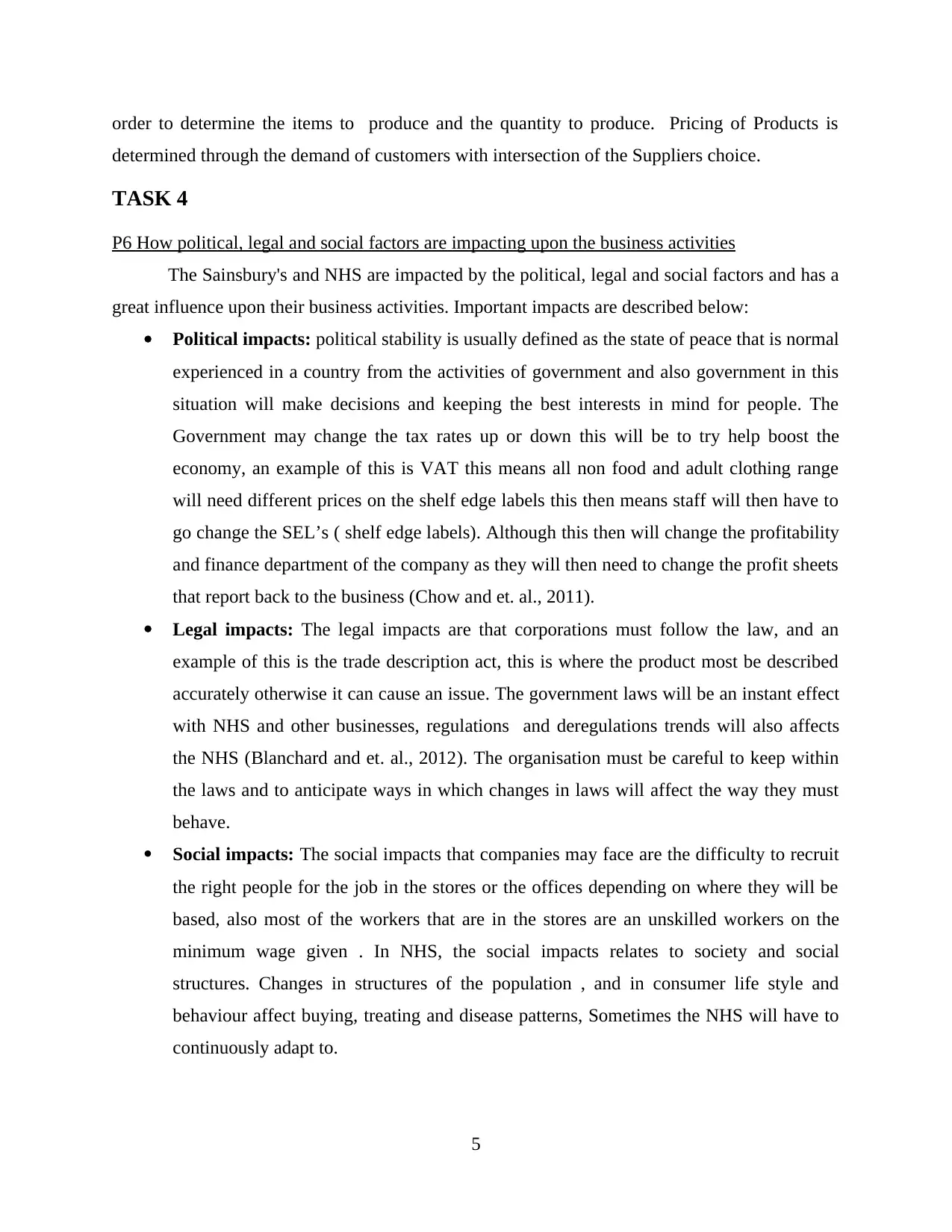
order to determine the items to produce and the quantity to produce. Pricing of Products is
determined through the demand of customers with intersection of the Suppliers choice.
TASK 4
P6 How political, legal and social factors are impacting upon the business activities
The Sainsbury's and NHS are impacted by the political, legal and social factors and has a
great influence upon their business activities. Important impacts are described below:
Political impacts: political stability is usually defined as the state of peace that is normal
experienced in a country from the activities of government and also government in this
situation will make decisions and keeping the best interests in mind for people. The
Government may change the tax rates up or down this will be to try help boost the
economy, an example of this is VAT this means all non food and adult clothing range
will need different prices on the shelf edge labels this then means staff will then have to
go change the SEL’s ( shelf edge labels). Although this then will change the profitability
and finance department of the company as they will then need to change the profit sheets
that report back to the business (Chow and et. al., 2011).
Legal impacts: The legal impacts are that corporations must follow the law, and an
example of this is the trade description act, this is where the product most be described
accurately otherwise it can cause an issue. The government laws will be an instant effect
with NHS and other businesses, regulations and deregulations trends will also affects
the NHS (Blanchard and et. al., 2012). The organisation must be careful to keep within
the laws and to anticipate ways in which changes in laws will affect the way they must
behave.
Social impacts: The social impacts that companies may face are the difficulty to recruit
the right people for the job in the stores or the offices depending on where they will be
based, also most of the workers that are in the stores are an unskilled workers on the
minimum wage given . In NHS, the social impacts relates to society and social
structures. Changes in structures of the population , and in consumer life style and
behaviour affect buying, treating and disease patterns, Sometimes the NHS will have to
continuously adapt to.
5
determined through the demand of customers with intersection of the Suppliers choice.
TASK 4
P6 How political, legal and social factors are impacting upon the business activities
The Sainsbury's and NHS are impacted by the political, legal and social factors and has a
great influence upon their business activities. Important impacts are described below:
Political impacts: political stability is usually defined as the state of peace that is normal
experienced in a country from the activities of government and also government in this
situation will make decisions and keeping the best interests in mind for people. The
Government may change the tax rates up or down this will be to try help boost the
economy, an example of this is VAT this means all non food and adult clothing range
will need different prices on the shelf edge labels this then means staff will then have to
go change the SEL’s ( shelf edge labels). Although this then will change the profitability
and finance department of the company as they will then need to change the profit sheets
that report back to the business (Chow and et. al., 2011).
Legal impacts: The legal impacts are that corporations must follow the law, and an
example of this is the trade description act, this is where the product most be described
accurately otherwise it can cause an issue. The government laws will be an instant effect
with NHS and other businesses, regulations and deregulations trends will also affects
the NHS (Blanchard and et. al., 2012). The organisation must be careful to keep within
the laws and to anticipate ways in which changes in laws will affect the way they must
behave.
Social impacts: The social impacts that companies may face are the difficulty to recruit
the right people for the job in the stores or the offices depending on where they will be
based, also most of the workers that are in the stores are an unskilled workers on the
minimum wage given . In NHS, the social impacts relates to society and social
structures. Changes in structures of the population , and in consumer life style and
behaviour affect buying, treating and disease patterns, Sometimes the NHS will have to
continuously adapt to.
5
Paraphrase This Document
Need a fresh take? Get an instant paraphrase of this document with our AI Paraphraser
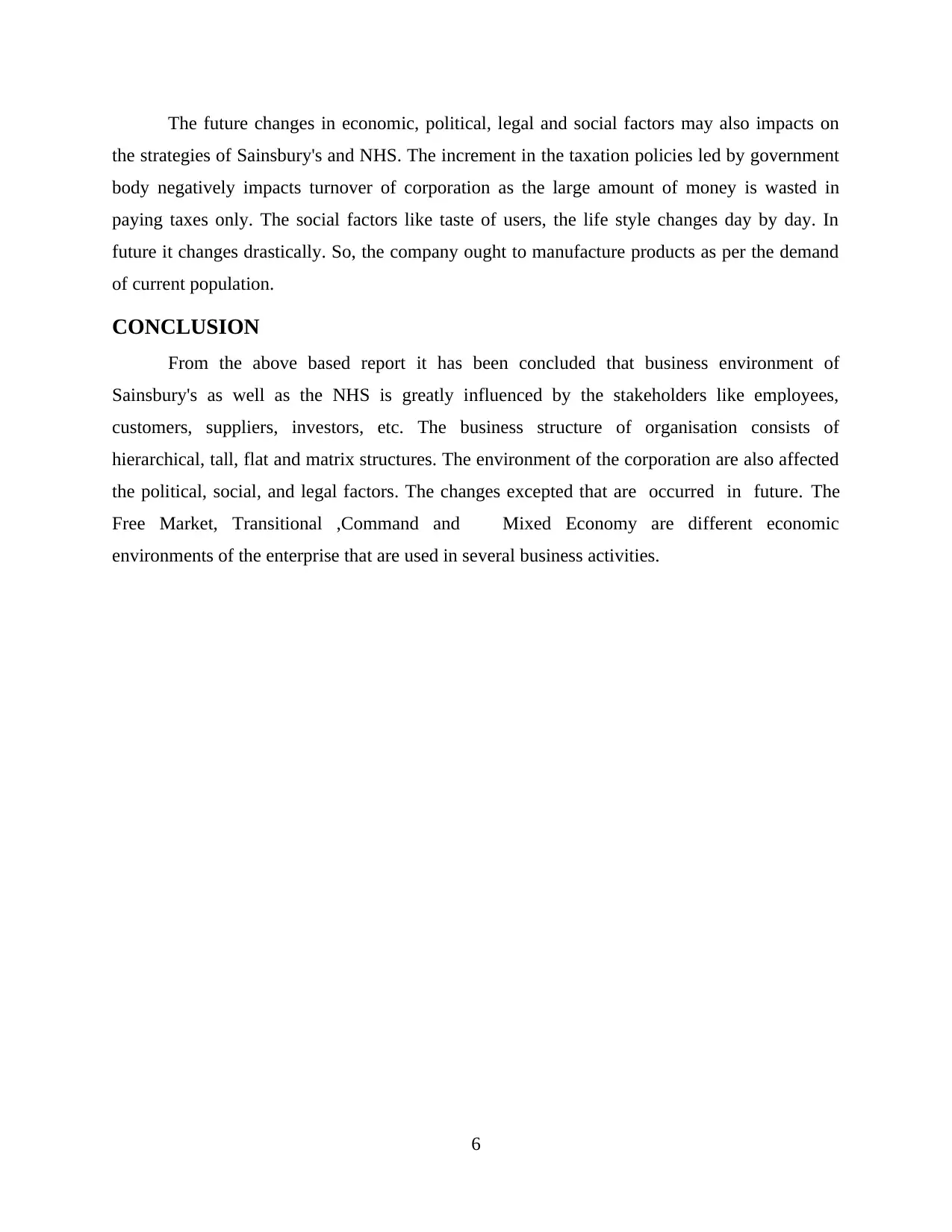
The future changes in economic, political, legal and social factors may also impacts on
the strategies of Sainsbury's and NHS. The increment in the taxation policies led by government
body negatively impacts turnover of corporation as the large amount of money is wasted in
paying taxes only. The social factors like taste of users, the life style changes day by day. In
future it changes drastically. So, the company ought to manufacture products as per the demand
of current population.
CONCLUSION
From the above based report it has been concluded that business environment of
Sainsbury's as well as the NHS is greatly influenced by the stakeholders like employees,
customers, suppliers, investors, etc. The business structure of organisation consists of
hierarchical, tall, flat and matrix structures. The environment of the corporation are also affected
the political, social, and legal factors. The changes excepted that are occurred in future. The
Free Market, Transitional ,Command and Mixed Economy are different economic
environments of the enterprise that are used in several business activities.
6
the strategies of Sainsbury's and NHS. The increment in the taxation policies led by government
body negatively impacts turnover of corporation as the large amount of money is wasted in
paying taxes only. The social factors like taste of users, the life style changes day by day. In
future it changes drastically. So, the company ought to manufacture products as per the demand
of current population.
CONCLUSION
From the above based report it has been concluded that business environment of
Sainsbury's as well as the NHS is greatly influenced by the stakeholders like employees,
customers, suppliers, investors, etc. The business structure of organisation consists of
hierarchical, tall, flat and matrix structures. The environment of the corporation are also affected
the political, social, and legal factors. The changes excepted that are occurred in future. The
Free Market, Transitional ,Command and Mixed Economy are different economic
environments of the enterprise that are used in several business activities.
6
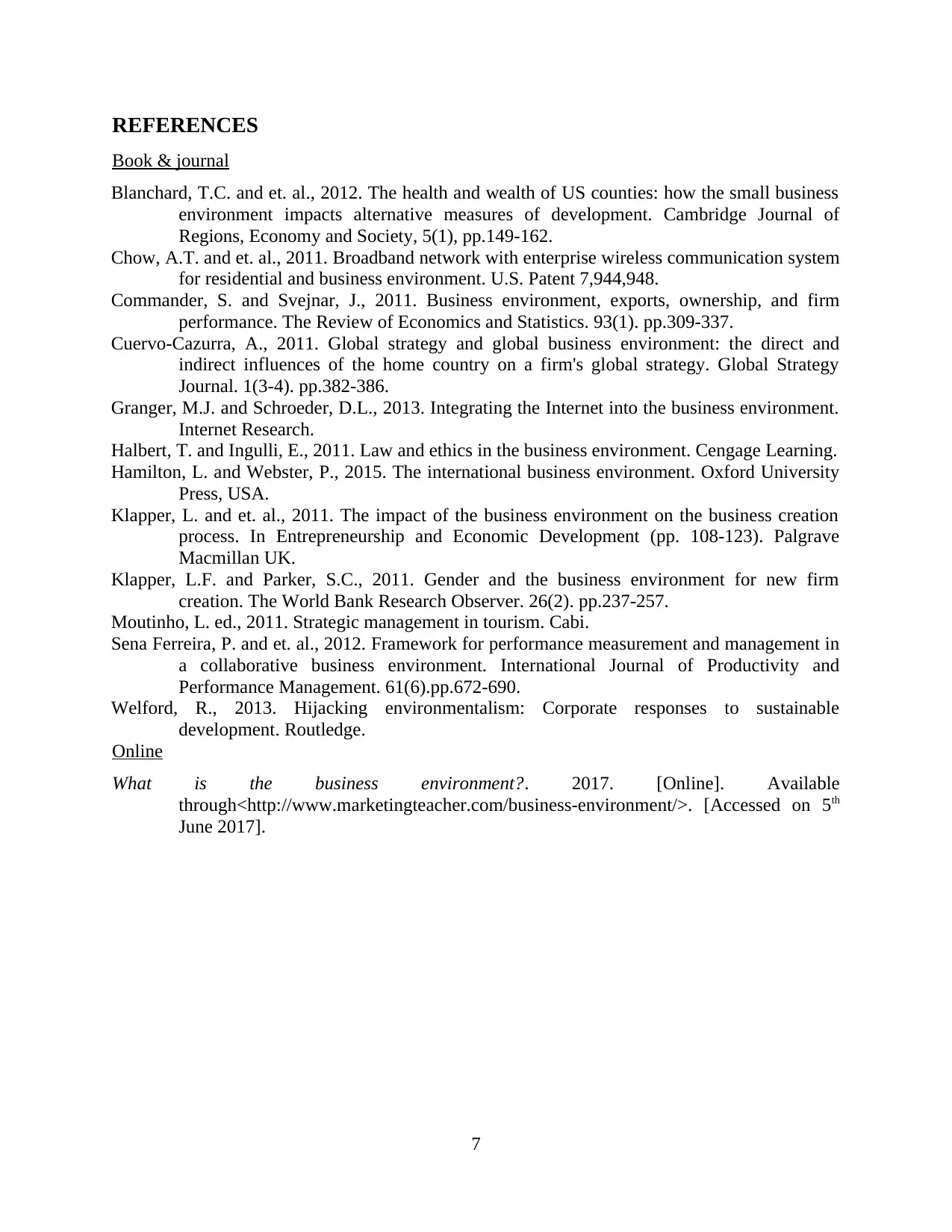
REFERENCES
Book & journal
Blanchard, T.C. and et. al., 2012. The health and wealth of US counties: how the small business
environment impacts alternative measures of development. Cambridge Journal of
Regions, Economy and Society, 5(1), pp.149-162.
Chow, A.T. and et. al., 2011. Broadband network with enterprise wireless communication system
for residential and business environment. U.S. Patent 7,944,948.
Commander, S. and Svejnar, J., 2011. Business environment, exports, ownership, and firm
performance. The Review of Economics and Statistics. 93(1). pp.309-337.
Cuervo‐Cazurra, A., 2011. Global strategy and global business environment: the direct and
indirect influences of the home country on a firm's global strategy. Global Strategy
Journal. 1(3‐4). pp.382-386.
Granger, M.J. and Schroeder, D.L., 2013. Integrating the Internet into the business environment.
Internet Research.
Halbert, T. and Ingulli, E., 2011. Law and ethics in the business environment. Cengage Learning.
Hamilton, L. and Webster, P., 2015. The international business environment. Oxford University
Press, USA.
Klapper, L. and et. al., 2011. The impact of the business environment on the business creation
process. In Entrepreneurship and Economic Development (pp. 108-123). Palgrave
Macmillan UK.
Klapper, L.F. and Parker, S.C., 2011. Gender and the business environment for new firm
creation. The World Bank Research Observer. 26(2). pp.237-257.
Moutinho, L. ed., 2011. Strategic management in tourism. Cabi.
Sena Ferreira, P. and et. al., 2012. Framework for performance measurement and management in
a collaborative business environment. International Journal of Productivity and
Performance Management. 61(6).pp.672-690.
Welford, R., 2013. Hijacking environmentalism: Corporate responses to sustainable
development. Routledge.
Online
What is the business environment?. 2017. [Online]. Available
through<http://www.marketingteacher.com/business-environment/>. [Accessed on 5th
June 2017].
7
Book & journal
Blanchard, T.C. and et. al., 2012. The health and wealth of US counties: how the small business
environment impacts alternative measures of development. Cambridge Journal of
Regions, Economy and Society, 5(1), pp.149-162.
Chow, A.T. and et. al., 2011. Broadband network with enterprise wireless communication system
for residential and business environment. U.S. Patent 7,944,948.
Commander, S. and Svejnar, J., 2011. Business environment, exports, ownership, and firm
performance. The Review of Economics and Statistics. 93(1). pp.309-337.
Cuervo‐Cazurra, A., 2011. Global strategy and global business environment: the direct and
indirect influences of the home country on a firm's global strategy. Global Strategy
Journal. 1(3‐4). pp.382-386.
Granger, M.J. and Schroeder, D.L., 2013. Integrating the Internet into the business environment.
Internet Research.
Halbert, T. and Ingulli, E., 2011. Law and ethics in the business environment. Cengage Learning.
Hamilton, L. and Webster, P., 2015. The international business environment. Oxford University
Press, USA.
Klapper, L. and et. al., 2011. The impact of the business environment on the business creation
process. In Entrepreneurship and Economic Development (pp. 108-123). Palgrave
Macmillan UK.
Klapper, L.F. and Parker, S.C., 2011. Gender and the business environment for new firm
creation. The World Bank Research Observer. 26(2). pp.237-257.
Moutinho, L. ed., 2011. Strategic management in tourism. Cabi.
Sena Ferreira, P. and et. al., 2012. Framework for performance measurement and management in
a collaborative business environment. International Journal of Productivity and
Performance Management. 61(6).pp.672-690.
Welford, R., 2013. Hijacking environmentalism: Corporate responses to sustainable
development. Routledge.
Online
What is the business environment?. 2017. [Online]. Available
through<http://www.marketingteacher.com/business-environment/>. [Accessed on 5th
June 2017].
7
⊘ This is a preview!⊘
Do you want full access?
Subscribe today to unlock all pages.

Trusted by 1+ million students worldwide
1 out of 9
Related Documents
Your All-in-One AI-Powered Toolkit for Academic Success.
+13062052269
info@desklib.com
Available 24*7 on WhatsApp / Email
![[object Object]](/_next/static/media/star-bottom.7253800d.svg)
Unlock your academic potential
Copyright © 2020–2025 A2Z Services. All Rights Reserved. Developed and managed by ZUCOL.





